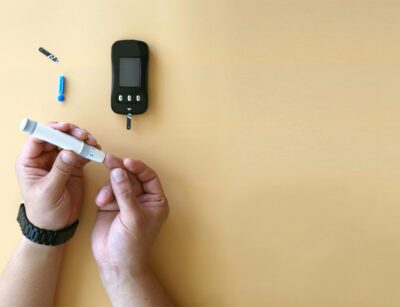We found out everything you need to know about premenstrual dysphoric disorder, the debilitating health condition with potentially fatal consequences.
If you have a uterus, the chances are you’ve experienced PMS. But what happens when it gets so bad that it affects your everyday life?
Premenstrual dysphoric disorder (PMDD) is a serious premenstrual disorder characterised by intense physical and emotional symptoms, which disrupt your ability to function properly. Just 20 years ago there was still debate around whether PMDD was a real health condition — and today it remains largely unheard of.
From PCOS and endometriosis to fertility and perimenopause, we’re seeing a real improvement in education around women’s health. So why don’t we know more about PMDD?
When a recent study published by JAMA Network Open found that women with premenstrual disorders are at a heightened risk of dying by suicide, I decided to speak to some experts to find out more about this debilitating and destructive condition.
What is premenstrual dysphoric disorder?
PMDD is a hormonal condition characterised by extremely severe premenstrual syndrome (PMS). Symptoms typically occur just after ovulation, one or two weeks before menstruation (known as the luteal phase) and usually begin to subside two to three days after the period starts.
Those with PMDD experience similar physical, emotional and behavioural symptoms to PMS, like bloating, irritability, tender breasts, insomnia and anxiety, but these symptoms are far more serious and often last for a longer time period.
Read more: How the menstrual cycle impacts your ability & motivation to exercise

How is PMDD different from regular PMS?
Historically unrecognised and often dismissed as ‘bad PMS’, in the UK a PMDD diagnosis is based on there being a “severe impact on the quality of life and the presence of a psychiatric component”, says Dr Jennifer Singh, a specialist in integrative women’s health and bioidentical hormone balancing for the Marion Gluck Clinic.
Unlike PMS, it’s characterised by the sufferer’s symptoms significantly impacting their ability to function at school or work and to socialise.
Lily, a director at a fast-paced PR agency, was diagnosed with PMDD a year ago. She finds that her symptoms make it impossible to work at her usual level of competency. “I become very confused, my ability to concentrate, be eloquent and produce good work goes completely out the window,” she says.
For Lily, the most challenging symptom is what she calls ‘warped thoughts’. She explains: “I turn from being a happy-go-lucky, sane and normal women to thinking the world is against me and my life is a disaster.”
Unsurprisingly, these frequent episodes of intense and uncontrollable emotions can have a profound effect on someone’s ability to form and maintain relationships.
“I was seeing someone for a long period of time who didn’t live in London and so I’d have to catch those moments where I could, and I didn’t want to see him like that,” says Lily. Often irritable, angry and listless, Lily explains, “not only physically did I often not feel up to it, but I didn’t feel able to engage in conversation.”
Considering it’s flagged as a condition where symptoms closely replicate the common experience of major depressive episodes, why is it still relatively unknown and underdiagnosed?
Read more: Everything you need to know about endometriosis

The trouble with PMDD diagnoses
Only relatively recently formally recognised in the Diagnostic and Statistical Manual of Mental Disorders, Fifth Edition (DSM-5), the main difficulties faced when getting a PMDD diagnosis are that most doctors don’t really understand it, or what it’s caused by. Current research suggests it may be linked to extreme sensitivities to hormone changes during the menstrual cycle but, as with many aspects of women’s health, more research is needed.
According to Dr Jennifer, other possible causes may be a dysfunction in the genes involved with oestrogen and serotonin breakdown, or a mismatch in receptor responses to progesterone’s breakdown (called allopregnanolone), which modulates mood in the brain.
“As there isn’t a straightforward test that can be used to diagnose someone with PMDD, the road to diagnosis is rarely a clear one,” explains Dr Samantha Wild, clinical lead for women’s health and GP at Bupa Health Clinics. “This means diagnoses rely heavily on those affected being able to describe their symptoms and make the correlation between when they occur during their cycle.”
Despite symptoms always occurring before a period, those affected often lose the ability to rationalise, gain perspective, remember why they’re happening and seek necessary help.
This is compounded by the irrational self-doubt inherent in the symptoms. Lily recalls finding it difficult to distinguish between whether her feelings were ‘real’ or caused by something else: “There are so many blurred lines — am I just depressed or down in the dumps or is this connected with my cycle?”
To make things even more difficult, when people do come forward, many don’t feel listened to or taken seriously by their GPs. As Dr Jennifer explains — PMDD is often dismissed as PMS.
Dr Samantha adds that a lack of faith in the healthcare system is also an issue: “If those with PMDD symptoms already feel they won’t be believed, the chance of them speaking to a health professional about what they’re going through is reduced.”
Often misdiagnosed as bipolar disorder, depression or a personality disorder, Dr Jennifer estimates that the figure of women affected by PMDD is far higher than the 5% to 8% currently accepted in the medical field.
And for such an isolating, disabling disorder with a profoundly destructive effect on people’s mental health, the consequences of these misdiagnoses are potentially fatal, as the psychological component of PMDD symptoms often shows up in the form of suicidal thoughts, explains Dr Jennifer.
“In the darkest of times, when the PMDD is bad, I definitely feel suicidal. It’s like a takeover of my whole personality — dark thoughts of just not wanting to be here,” reveals Lily.
Read more: Struggling with fatigue? Inflammation may be the cause

Can PMDD be treated?
Like many hormonal disorders, PMDD can’t be cured, but the symptoms can be managed. Years ago, doctors often resorted to a premature hysterectomy to put an end to symptoms, Dr Jennifer tells me. But less invasive treatments are now more common, such as hormone replacement therapy (HRT), specific antidepressants and the combined hormonal contraceptive pill.
However, determining the appropriate treatment for the individual relies heavily on first receiving an accurate diagnosis and then on the guidance of a dedicated, supportive and conscientious specialist or GP.
“Even if PMDD is suspected, health professionals need adequate education around which clinical services to refer those affected to,” says Dr Samantha.
But there are self-help measures people can take to manage symptoms. Dr Jennifer recommends regular exercise, sleeping between seven and nine hours a night and maintaining a balanced diet. This may seem trivial, but one year on from her diagnosis, Lily has found various ways to cope (through her own trial and error), such as mindfulness, a wholegrain diet, fasting and seed cycling. “For me it’s all about lifestyle — reducing stress and putting as little pressure on yourself as possible around these times.”
Dr Jennifer emphasises that even though the understanding of PMDD has come a long way, the continued support of those affected is crucial: “I hope that women can now feel validated and receive the help they need to be able to obtain a clear diagnosis and effective treatment for this debilitating condition — and start living life again.”













